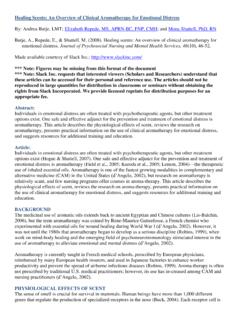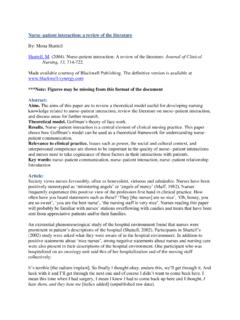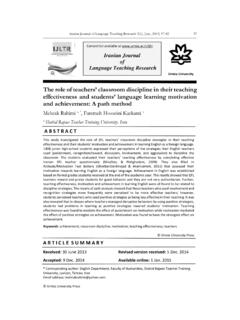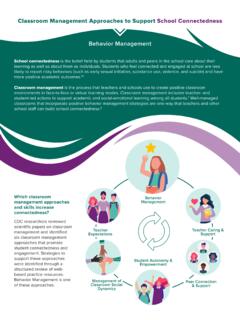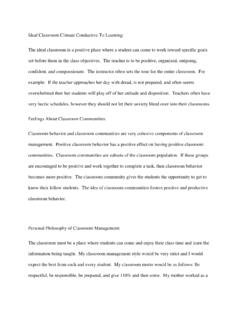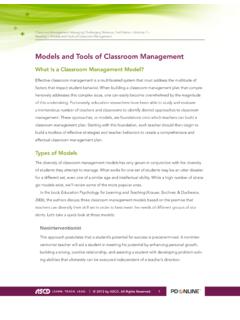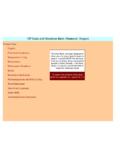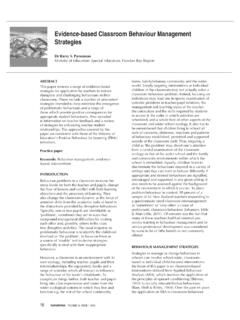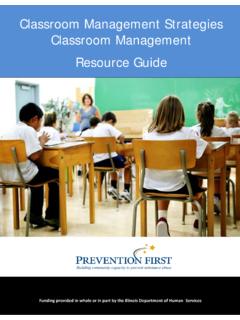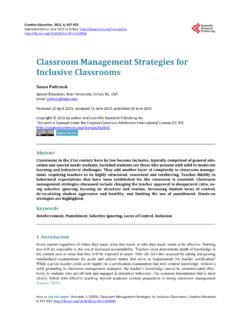Transcription of Positive and Negative Reinforcement Student Behavior in a ...
1 2 Gooch Acknowledgements The completion of this research project was accomplished with the help of my faculty mentor, Dr. Kelly Ficklin. I would like to thank the Esther G. Maynor Honors College and Dr. Teagan Decker for the continued support and guidance as I. underwent this research. In addition, I would like to thank my clinical teacher , Mrs. Helen Clark, for her suggestions and classroom management ideas. This project would not have been possible without all the support I received. Gooch 3. Abstract classroom management is one of the greatest obstacles for educators. There are many theories and state mandates about the proper way a teacher should handle Student misbehavior.
2 The most common forms of classroom management are assertive discipline and cooperative discipline. Assertive discipline is the most commonly used management style in the United States, but it is unknown if it is the most effective. This study will compare and contrast assertive and cooperative discipline through literary research and through observations in a second grade classroom . This research focuses on three sample students with various levels of behavioral issues ranging from mild, moderate and severe. Students were observed and recorded using an assertive discipline approach for 1 week and a cooperative discipline approach for 1 week. 4 Gooch Positive and Negative Reinforcement Related to Student Behavior in a classroom Setting Introduction classroom management is among the most challenging parts of teaching for educators, especially for beginning teachers (Gordon, 2001).
3 Subsequently, disruptive Behavior is a primary reason teachers leave the profession (Thangarajathi & Joel, 2010). In addition to classroom management , a teacher is responsible for classroom setting and decorations, classroom arrangement, responses to students, developing rules, and communicating those rules (Sieberer- Nagler, 2015). Although Thangarajathi and Joel found sound Behavior management does not guarantee effective instruction, it provides the layout for productive teaching (Thangarajathi & Joel, 2010 p. 11). There are different levels of Student misbehavior. The first level is a minor disturbance. Minor disturbances include holding hands, playing with classroom equipment, and gum chewing.
4 The second level includes more difficult problems or moderate behaviors such as tattling, talking, crying and inappropriate touching. The third category is considered very difficult problems and includes crude language, obscene gestures, extremely disruptive behaviors, complete lack of participation, and sexually explicit comments. The most difficult category involves physical violence and weapons (Gordon, 2001). These problems are also subcategorized into aggressive Behavior , dependent Behavior , or academic Behavior . Aggressive Behavior consists of physical actions. For example, if one Student pushes another Student , or if a Student gets frustrated and throws their homework across the room.
5 Dependent Behavior includes distractions (eg., loud gum chewing), inattentiveness Gooch 5. or crying. If a Student does not turn in a homework assignment or fails to work on classwork, it is an example of academic misbehavior (Smith 1978). Because there are multiple types of classroom behaviors, there are many ways to react to the situation. Many educators will not challenge certain behaviors because they tend to not be egregious. Other teachers may also feel they are to blame for the bad Behavior , therefore are hesitant to deal with disruptions. Some researchers suggest that in almost all cases, there should be a teacher reaction. In other words, never ignore the bad Behavior .
6 The longer the bad Behavior is ignored, the longer it will continue and it will be harder to stop in the future (Thangarajathi & Joel, 2010). Research has shown there are specific solutions to classroom Behavior problems. Gordon suggests that level one behaviors can be solved with physical proximity to the Student . The teacher must move toward the Student , make eye contact and intervene quickly. This way the class flow is not interrupted for minor disturbances but the problem is still handled. Level 2 problems can be solved with physical proximity, short admonitions, diverting Positive attention to other students, encouraging students to express discomfort, or pointing out inappropriate Behavior accordingly (Gordon, 2001).
7 Level 3 disturbances could be solved with confronting students directly, moving students, quick interventions, and directing students to think about their actions. Students who are fighting or carrying a weapon should be removed from the classroom immediately to ensure the safety of other students. A school administrator should be notified, as well as the school counselor (Gordon, 2001). There are basic management strategies used by teachers, but styles of discipline are 6 Gooch separated into two distinct categories: assertive discipline and cooperative discipline. Assertive Discipline The assertive discipline style, created by Lee and Marlene Cantor in 1976, is the most commonly used form of discipline in the United States.
8 Assertive discipline places the teacher in a take-charge, authority role. Daily procedures are teacher oriented and the teacher creates all rules. As a result, the teacher chooses Negative consequences, punishments, Positive consequences, and rewards. Lee Cantor explains assertive teachers' need to establish clear rules for the classroom , communicate those rules to the students, and then teach the students how to follow them (Cantor, 1989). Cantor believes Positive Reinforcement should be used at least once a day. In addition, firm and consistent Negative consequences should occur after a Student chooses to break the rules. Cantor explains there should be a systematic, clear discipline plan in place for students.
9 The teacher should explain these rules to the students at the beginning of the year and be consistent while implementing those rules. Cantor argues that without a discipline plan teachers are inconsistent and ineffective (Cantor, 1989). Cantor argues that his discipline style has been interpreted differently than intended. For example, many educators believe after every misbehavior there should be a Negative consequence (check marks, name on the board, etc.). However Cantor asserts that Negative Reinforcement should be used as a last resort (Cantor, 1989). However, Cantor suggests teachers have a pre-made list of five consequences for Student misbehavior. For example, Cantor suggests the first time a Gooch 7.
10 Student breaks the rules the Student is warned , the second time ten minute time- out , the third time 15 minute time out , the fourth time the parent is called and the fifth time the Student goes to the principal office (Cantor, 1989 p. 59). Cantor believes the discipline should be age appropriate and never degrading or physical. Cantor originally suggested writing names on the board, but after parent disapproval or misinterpretation he claims it is not a necessary part of his discipline system. Cantor feels parents and teachers have misconstrued assertive discipline. Cantor believes the assertive discipline model is effective based on research but opponents of assertive discipline claim there is no evidence of the effectiveness of the approach (Render, Padilla, & Krank, 1989).





